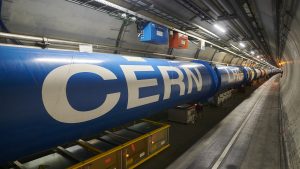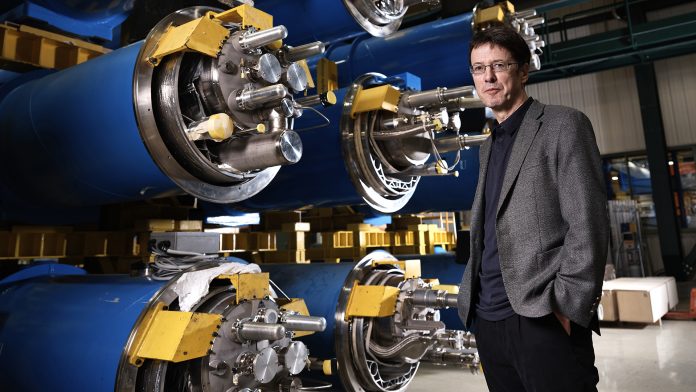Ahead of Run 3 of the Large Hadron Collider, The Innovation Platform spoke to Mike Lamont, Director for Accelerators and Technology at CERN, to find out what this next phase could mean for physics discoveries.
2022 has been a year of major significance for the European Organization for Nuclear Research (CERN), as it marked the restart of its Large Hadron Collider (LHC). The LHC, the world’s largest and most powerful particle accelerator, was switched back on in April following a three-year shutdown period, known as the ‘Long Shutdown 2’, for essential maintenance work and major upgrades.
The LHC consists of a 27km ring of superconducting magnets with a number of accelerating structures to boost the energy of the particles. Inside the accelerator, two high-energy particle beams travel in opposite directions at very close to the speed of light. Typically, following injection and a ramp-up in energy, the same beams circulate for many hours continually producing proton-proton collisions in the centre of the main detectors.
There are a total of eight experiments, run by collaborations of scientists from around the world, at the Large Hadron Collider that use detectors to analyse particles produced by collisions in the accelerator. The biggest experiments are ATLAS and CMS, which use general-purpose detectors to investigate the largest range of physics possible. Other major experiments include ALICE and CMS, which have detectors designed to focus on specific phenomena.
Since its initial operation in 2010, the Large Hadron Collider has been the driving force behind several major discoveries in physics. The most prominent discovery, which celebrated its tenth anniversary this July, was that of the Higgs boson. Hailed light-heartedly as the ‘God particle’, the Higgs boson is the fundamental particle associated with the Higgs field – a field that gives mass to other fundamental particles, such as electrons and quarks. Physicist Peter Higgs initially developed the concept of the Higgs boson in the 1960s, but it was only confirmed in 2012 when it was observed by the ATLAS and CMS experiments at CERN.
On 5 July 2022, the LHC entered a new period of data taking, known as Run 3, for the experiments. Running at its highest collision energy yet, the changes made to the LHC during the shutdown will enable the experiments to take larger data samples of higher quality than previous runs.
Ahead of the start of Run 3, The Innovation Platform Editor Georgie Purcell spoke to Mike Lamont, Director for Accelerators and Technology at CERN, to find out the major hopes and aims for the restart.
The next run of the LHC will launch on 5 July. How are preparations going for this? Have you encountered any issues since the collider was switched on?
We started up with the first beam just after Easter and progress has gone fairly well so far. We had to follow a commissioning plan, which has taken about two months, to prepare everything before we can safely go into collisions in conditions that the detectors are able to switch fully on. The Large Hadron Collider is an immensely complicated beast, and during this process, a whole swathe of activity is going on, including system commissioning, detailed beam set-up, machine protection tests, etc. The teams are working around the clock from the control room to organise things, carry out tests and solve any problems encountered.
No serious problems have occurred since the collider was switched back on. There is a huge amount of kit out there and so, of course, a lot of things can and do go wrong. However, after ten years of experience, we are used to tackling these issues and, up to now, things look in good shape.
What is it hoped that the new capabilities of the LHC will be able to achieve?
Run 2 was very successful and we are going up to a higher energy in Run 3. We are now running at a beam energy of 6.8 TeV, compared to 6.5 TeV previously. It is not a massive step up, but it is a move towards our nominal design energy of 7 TeV. This is a remarkably high energy for an earth-based proton!
The really significant performance indicator is the number of collisions that we deliver to the experiments. ATLAS and CMS, known as ‘general purpose detectors’, are our big clients and carry out detailed Higgs characterisation and searches beyond the Standard Model. These experiments have undergone upgrades during our most recent Long Shutdown and are now prepared for more data at higher rates.
In particular, we have had major upgrades in the injectors and have connected a new Linac – Linac 4 – to the next machine in the chain, the Proton Synchrotron Booster. There has been a whole swathe of other improvements across the injector complex as part of the LHC Injector Upgrade project. The injectors can now deliver more intense bunches of protons i.e., more protons per bunch, whilst keeping very small transverse beam sizes. This will mean that, when we pass the bunches through each other in the LHC detectors, we are able to create more collisions and maintain these very high rates of collisions for a longer time period. The aim is to deliver an integrated number of collisions to the experiments over the next four-year period, double that already delivered up to this point – i.e. a massive data sample at a higher energy.
The other two big experiments are LHCb and ALICE, and they have also had major upgrades to vastly increase their data-taking potential. The LHCb has previously found some intriguing anomalies in its accumulated data. It is hoped that this experiment will now be able to obtain enough data in Run 3 to confirm or deny those hints at potentially new physics. Interesting times lie ahead.
What could Run 3 mean for Higgs research and, in particular, for discoveries beyond the Standard Model?
The Higgs is a profoundly important discovery and a potential portal to new physics. Any deviations from the Standard Model expectations could give hints of new so-called Beyond Standard Model (BSM) principles at work. What has been revealed up to now could be described as ‘vanilla Higgs’, but there remains a lot more data to collect, and many more studies to be carried out – the Higgs really needs to be subjected to precise experimental scrutiny, and Higgs studies are very much part of the plan moving forward.
What have been the major challenges in getting the collider to the point of operation? How were these overcome?
The backbone of the machine is the superconducting magnets. The first challenge coming out of the shutdown was to cool the magnets to 1.9 K with superfluid helium before we could start powering them. We achieved this by using industrial-scale cryogenics and around 150 tonnes of helium to cool the magnets. The cryogenics team have wrestled the system to a remarkable level of reliability over the year and understand the process very well.

Powering the magnets is, again, fairly standard practice. We use around 11,600 amps in the main dipoles for 6.8 TeV, however, the magnets themselves have proved quite challenging. The magnets produce very strong magnetic fields and are technological marvels. Huge forces are produced at high field, and we have a phenomenon called ‘training’ where we can get microscopic movement of the superconducting cables which generate small amounts of heat, enough to turn part of the cable resistive. This is what we call a ‘quench’. When a quench is detected, the quench protection system kicks in, the current is discharged, internal heating strips warm the whole magnet up and, safely handles the situation. It takes about eight hours to cool the magnet string back down, before we then repeat the process. The big challenge of 2021 was training the dipole circuits up to the higher energy – it took over 600 training quenches; the Large Hadron Collider has 1,232 main dipoles in total.
While we were performing in this ‘training campaign’, we had an internal electrical short in one magnet. We had to warm the sector up, change the magnet, cool it back down and start again – a five-month exercise. On another magnet in another sector, we lost a protection diode. We again had to carry out a warm-up and cool-down process. After we had fixed these problems, last October we took beam at low energy for a two-week test run and we found an obstacle in a vacuum pipe in an interconnect between two magnets. We had to warm the sector up, open up the machine and fix the problem, which took another five months to complete. Work on the other sectors could continue during these repairs.
What implications have societal issues such as COVID-19 and the conflict in Ukraine had on the progress of the LHC? What potential impact will the termination of CERN’s ICAs with Russia and Belarus in 2024 have on future research?
We were affected by COVID-19 and it slowed our progress down. However, we reacted well on the ground by implementing a full range of preventative measures to ensure that we could continue to work safely. This was successful and the team adapted well to the measures, meaning that, with both the experiments and the machine, we were able to complete what needed to be done, albeit with some delay.
For the LHC machine itself, Russia’s attack on the Ukraine has not had a big impact. We have Russian colleagues here at CERN and longstanding relationships with institutes in Russia, but we were not heavily dependent on them for the operation of the machine.
The experiments, however, are more exposed as they have longstanding operation and maintenance relationships with Russia, so this has had quite an impact. Operationally, they can adapt so the actual Run 3 and the operation of the present Large Hadron Collider has not been too largely impacted by the Russian invasion of Ukraine.
It has been a more drastic impact for the planned experiment upgrades because Russian institutes were actually producing components on site in Russia. Some of the specialised production capabilities do not currently exist elsewhere in Europe, so there is a significant impact that will have to be absorbed by funding agencies that contribute to the upgrades of experiments.
The experiments have a lot of Russian colleagues in their ranks, some of whom have been at CERN for quite some time, as part of the user community. For the moment, the International Cooperation Agreement (ICA) between CERN and Russia has not been cancelled so they can maintain their affiliation with the Russian institutes. This means they can stay at CERN and continue to contribute to the life of the experiments. By leaving the ICA in place, we are keeping a bridge in place but ensure that nothing crosses the bridge under the present circumstances. When it comes to material and finances, we must respect the sanctions and restrictions that have been put in place. On the machine side, we have really cut collaboration and communications with our ex-collaborators in Russia.
What has been an issue is the development of the High-Luminosity LHC (HL-LHC) – the next major upgrade of the Large Hadron Collider – planned for 2026-2028. The HL-LHC will be accompanied by big upgrades to the experiments – particularly ATLAS and CMS. The Russian institutes are heavily implicated in those upgrades. On the machine side, this has meant we have had to insource what the Russians were contracted to do. As the machine is CERN-financed, the effects are something we have had to absorb into our existing budget. We have also had to upskill – in a few cases to cover what the Russians were doing previously. Of course, this can be achieved over time, but a knock-on effect to the schedule and project finances is likely.
Mike Lamont
Director for Accelerators and Technology
CERN
www.home.cern
Mike.Lamont@cern.ch
https://www.linkedin.com/company/cern/
https://www.facebook.com/cern/
https://twitter.com/CERN?ref_src=twsrc%5Egoogle%7Ctwcamp%5Eserp%7Ctwgr%5Eauthor
Please note, this article will also appear in the eleventh edition of our quarterly publication.



